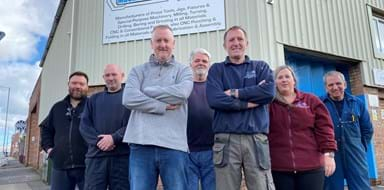
A Cumbrian manufacturer of joinery products has ambitions to double its production capacity and profits using an Industry 4.0-ready, five axis CNC machine and software through Made Smarter advice and financial support.
For the last 12 years James Tanner Joinery has been designing and manufacturing hardwood and softwood products used in the commercial and private sectors.
The Kendal-based business has built a reputation for designing, manufacturing and installing quality, bespoke sash windows, doors and staircases.
But production has been at capacity for years because of its current machining processes, and growth is being stifled.
Managing Director James Tanner and his team of three, know that to take the next step forward the business will need to embrace advanced manufacturing technologies.
View the Case StudyHaving a complete overview – which can be monitored remotely – is game changing for us. Having time management for jobs will show gaps in production and enable the most efficient use of the machine and staff.
James Tanner, Managing Director of James Tanner Joinery
To make a window, the current process is extremely manual and requires wood being moved between three machines - a tenoner, a spindle moulder and a morticer.
Meanwhile, the parts used in staircases are made using a handheld router and jig.
James explained: “From initial set up, to ensuring the join is good, the simplest window would take up to 60 minutes. That includes some machining, then some benchwork and then back to the machine. It is the manual intervention that is the challenge.”
“If my guys are out installing the products then the work backs up and can cause 8 -12 weeks delivery time. It’s a battle keeping that down. No one wants lead times like that.”
Business is good for James, but for the last four years turnover has remained at a steady £300k.
“That consistency shows that we are at capacity,” he said. “There is only so much we can do in terms of machining. We simply have to find a way to stop turning business away.”
The company has embraced digital tools, such as design software and time management software which have helped keep jobs on time and within budget.
Now, with matched funding from Made Smarter, the company has committed to an integrated solution, comprising an Industry 4.0-ready five axis CNC machine and software suite of tools.
The machine will remove labour-intensive processes and link to a new cloud-based design software, which tracks the life journey of the product from customer enquiry, design and prototype using fully rendered 3D imaging, material management, to manufacture and delivery.
James said: “This solution means that we can do all the design work and programming before, put the wood into the machine and let it do its job, all in one go.”
With the new technology, that window that took 60 minutes to machine, will now take four and a half minutes – 13 times quicker – with higher level of accuracy.
If you take into account the new design process and software programming, job time is expected to reduce by 50%.
The solution offers predictive maintenance, live and historical data analysis, downtime analysis and cloud-based data storage with remote access.
James said: “Having a complete overview – which can be monitored remotely – is game-changing for us. Having time management for jobs will show gaps in production and enable the most efficient use of the machine and staff. It’s like having another person – but one who doesn’t answer back or call in sick.”
That being said, James does plan to bring in a new member of the team to programme and operate the CNC machine.
By doubling its production capacity, the business can then take on that extra commercial work. All being well, James Tanner Joinery forecasts it could increase turnover to £500,000 – a 66% boost – by 2022.
The region is also expected to see GVA increase by £332,727 from the investment.
But beyond the profit, James is as excited by the benefits in accuracy.
“Our motto has always been ‘precision made joinery’,” James said. “Accuracy is really important to me, to the reputation of this company. There’s not a ‘good enough’ with me. Our work must be an engineering standard, which is very difficult using wood.
“This new solution takes our ability to achieve that accuracy to the next level.”
This is a major leap forward for James Tanner and its digital roadmap.
The next step involves investing in new 3D design software to expand into bedroom and kitchens.
3D scanning, VR and potentially AR technologies are also being explored with Made Smarter as ways of accelerating the design cycle further and enhance customer experience.
James said: “I want to be able to go to a job, measure or scan the key parameters, sketch a design and go back to the office to produce a 3D design. It then goes from screen to machine.
“Now we have taken this first step, I can see the possibilities. And that is very exciting.”








